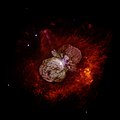Fáìlì:Eta Carinae.jpg
Ìrísí

Ìtóbi ìkọ́yẹ̀wò yìí: 600 × 599 pixels. Àwọn ìgbéhàn míràn: 240 × 240 pixels | 480 × 480 pixels | 769 × 768 pixels | 1,025 × 1,024 pixels | 2,015 × 2,013 pixels.
Fáìlì àtìbẹ̀rẹ̀ (2,015 × 2,013 pixel, ìtóbi faili: 163 KB, irú MIME: image/jpeg)
Ìtàn fáìlì
Ẹ kan kliki lórí ọjọ́ọdún/àkókò kan láti wo fáìlì ọ̀ún bó ṣe hàn ní àkókò na.
| Ọjọ́ọdún/Àkókò | Àwòrán kékeré | Àwọn ìwọ̀n | Oníṣe | Àríwí | |
|---|---|---|---|---|---|
| lọ́wọ́ | 09:41, 18 Oṣù Ọ̀pẹ̀ 2017 |  | 2,015 × 2,013 (163 KB) | The NMI User | Reverted to version as of 14:14, 1 May 2008 (UTC) |
| 14:45, 13 Oṣù Ẹ̀rẹ̀nà 2017 |  | 3,000 × 2,998 (1.18 MB) | Leogorgon | larger file size | |
| 14:14, 1 Oṣù Ẹ̀bìbì 2008 |  | 2,015 × 2,013 (163 KB) | Vol de nuit | {{Information |Description=(NASA News Release) A huge, billowing pair of gas and dust clouds are captured in this stunning NASA Hubble Space Telescope image of the supermassive star Eta Carinae. Using a combination of image processing techniques (ditheri |
Ìlò fáìlì
Kò sí ojúewé tó únlo fáìlì yìí.
Ìlò fáìlì káàkiri
Àwọn wiki míràn wọ̀nyí lo fáìlì yìí:
- Ìlò ní da.wikipedia.org
- Ìlò ní en.wikipedia.org
- Star
- Eta Carinae
- Wikipedia:Selected anniversaries/March 11
- Wikipedia:Today's featured article/March 2017
- Wikipedia:WikiProject Wikipack Africa Content/Wikipedia:Showcase
- Wikipedia:WikiProject WikiFundi Content/Eta Carinae
- Wikipedia:Today's featured article/requests/Eta Carinae
- Wikipedia:Today's featured article/March 12, 2017
- Wikipedia:Main Page history/2017 March 12
- Wikipedia:WikiProject WikiFundi Content/Wikipedia:Showcase
- Wikipedia:Main Page history/2022 March 11
- Wikipedia:Main Page history/2022 March 11b
- Wikipedia:Main Page history/2023 March 11
- Wikipedia:Main Page history/2023 March 11b
- User:2003 LN6/sandbox/Eta Carinae variable
- List of luminous blue variable stars
- Ìlò ní en.wikiversity.org
- User:Marshallsumter/Radiation astronomy2/Visuals
- User:Marshallsumter/Radiation astronomy2/Violets
- Stars/Astronomy
- User:Marshallsumter/Radiation astronomy2/Violets/Quiz
- Stars/Sun/Astronomy/Quiz
- User:Marshallsumter/Radiation astronomy/Courses/Principles/Hourly 2
- User:Marshallsumter/Radiation astronomy/Courses/Principles/Final quiz
- Draft:Original research/Io/Quiz
- Titan/Quiz
- Stars/Solar systems/Quiz
- Moon/Quiz
- Earth/Quiz
- User:Marshallsumter/Radiation astronomy/Colors/Quiz
- Volcanoes/Io/Quiz
- Stars/Violets
- User:Marshallsumter/Radiation astronomy2/Stars
- Stars/Violets/Quiz
- Ìlò ní es.wikipedia.org
- Ìlò ní fr.wikipedia.org
- Ìlò ní hi.wikipedia.org
- Ìlò ní it.wikibooks.org
- Ìlò ní la.wikipedia.org
- Ìlò ní mk.wikipedia.org
- Ìlò ní ms.wikipedia.org
- Ìlò ní my.wikipedia.org
- Ìlò ní oc.wikipedia.org
- Ìlò ní ru.wikipedia.org
- Ìlò ní sk.wikipedia.org
- Ìlò ní sr.wikipedia.org
- Ìlò ní th.wikipedia.org
Ìfihàn ìlò míràn púpọ̀ fún fálì yìí.

